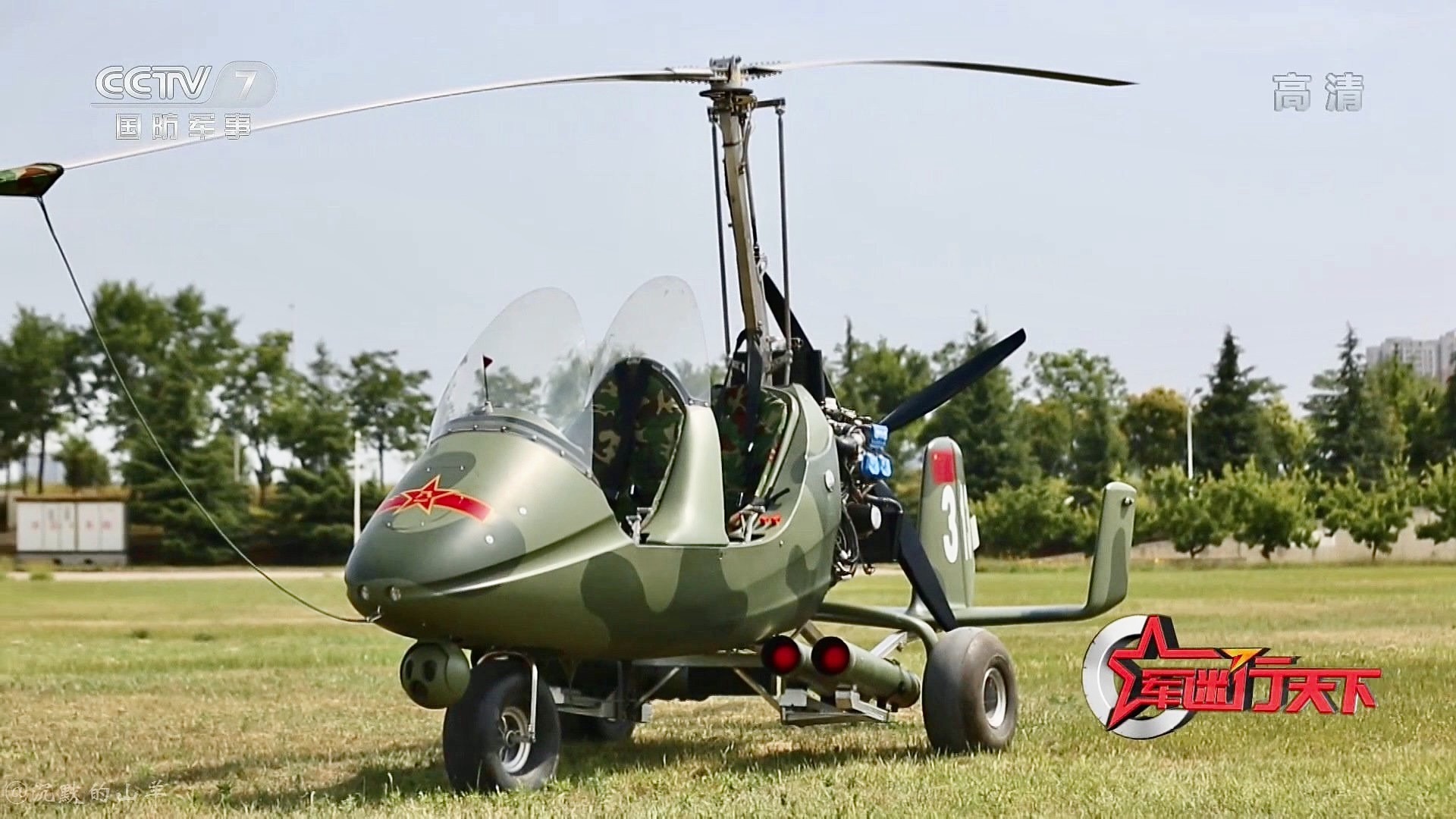Video released by China’s state-operated television network, CCTV, shows the first gyrocopter operated by the People’s Liberation Army (PLA) equipped with anti-tank missile launchers and a small sensor turret.
The video was aired on the CCTV7 television channel, which is dedicated to news about the PLA, although the exact date the feature was released is unknown. Readers can watch the full video below.

In the footage, we see a two-seat gyrocopter loaded out with four anti-tank guided missiles (ATGMs,) two on each of the aircraft’s underside hardpoint extensions. The gyrocopter also appears to be equipped with a small sensor turret under its nose, which could be used to find targets, aim and guide the missiles (depending on their guidance method), and provide for more general surveillance and reconnaissance type tasks. The footage also depicts a fleet of unarmed gyrocopters performing training exercises and stunts.
Taken at face value, the addition of ATGMs and a sensor turret marks an important upgrade to the PLA’s gyrocopters in terms of munitions – the latest image we have seen of these aircraft shows one boasting small precision-guided bombs, without a sensor ball.
It isn’t clear just how real this capability is, either. The ATGM tubes and sensor ball don’t exactly look like high-grade installations. Regardless, even if it is aspirational in nature or in development, it is still quite interesting.
The Shaanxi-based defense manufacturer, Shaanxi Baojii Special Vehicles Manufacturing Company, first began producing its “Shaanxi Baojii Special Vehicles Lie Ying Falcon,” or “Hunting Eagle Strike Gyrocopter,” for the PLA in August 2014. At least publically, they were designed for PLA special forces. More photos of PLA gyrocopters can be found here.

The “Hunting Eagle” comes in different configurations, including single and multiple-seat variants. According to the company, its two-manned gyrocopter has a range of around 250 miles and boasts a maximum gross weight of around 1,235 pounds. Unlike helicopters, which rely on a dedicated motor to power their rotors, gyrocopters fly by means of autorotation. A rear-facing pusher engine powers a propeller. The thrust and motion from this rearward prop propel the aircraft’s main blades.
While the use of armed and unarmed gyrocopters by the PLA has been known for some time, their association with the Chinese military became more widely known in 2019, following their presence at a military parade to commemorate the 70th anniversary of the founding of the People’s Republic of China. It’s likely that the unarmed gyrocopters seen in the recent CCTV7 video are close in design to those displayed in 2019.

Gyrocopters are slow but nimble. These aircraft can perform very short takeoffs and land with very high approach angles in small areas. They are very easily concealed, making them easy to transport for all sorts of covert reconnaissance missions, as well as for border patrols and search and rescue operations. Their ability to travel low and slow and their small radar and thermal signatures makes them hard to detect, as well.
The People’s Armed Police (PAP), a Chinese national-level paramilitary gendarmerie, have favored gyrocopters for aerial surveillance and security assistance. A video demonstration of the PAP’s gyrocopters in use can be seen below.
While we’ve seen images of PLA gyrocopters performing military exercises, notably in Tibet last year, it remains unclear precisely how the PLA would use gyrocopters fitted with ATGMs and sensor balls. The Twitter user @OsintTv argues that PLA spokespeople in the CCTV7 video revealed that they could be deployed along the Sino-Indian border to combat Indian tanks and other vehicles. The border between the two countries remains a site of heightened tension, which readers can learn more about here and here.
In the video, a rough translation describes how the armed gyrocopters are intended to support ground forces and hunt and kill tanks. It’s also noted that some measures have been taken to quiet the aircraft. In addition, a good point is made in that training pilots to fly gyrocopters is relatively easy and their logistical footprint is absolutely tiny, which is a big benefit for austere operations.
Editor’s note: YES, this gives off major Bond vibes, and for good reason — remember this scene from You Only Live Twice?!

Of course, it remains doubtful how capable these gyrocopters would prove in an active, modern war zone. If deployed along the Sino-Indian border, facing down Indian tank regiments, the aircraft could be vulnerable to the sorts of air defenses that accompany mobile units and ground troops during a high-end conflict. The degradation in performance of these aircraft in a high-altitude combat environment is also worth considering. But as a very low-cost patrol and surveillance aircraft with contingent light attack capabilities that pretty much anyone can be taught to fly and maintain, it might make some sense.
Regardless, it is just another quirky facet of a growing PLA that includes everything from very high-end aerial capabilities like stealthy fighters all the way down to little autogyros with missiles slapped on their sides.
Contact the author: oliver@thewarzone.com, joe@thedrive.com
